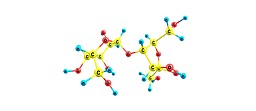Method for Catalytic Glycosylation
TECHNOLOGY NUMBER: 2019-237

OVERVIEW
Scalable catalytic synthesis of oligosaccharides- High yield synthesis of even complex, synthetic polysaccharides
- High reaction selectivity for versatile polysaccharide designs
BACKGROUND
Glycosylation, or the forming of glycosidic bonds between sugar molecules to produce oligo and polysaccharides, is one of the basic biological enzymatic reactions. Glycosylation is a common post-translational modification process in which a carbohydrate, specifically a glycan, is covalently attached to a protein, lipid, or another organic molecule. This process is essential for the structure, stability, and function of many biological molecules. Poly and oligosaccharides can also be synthesized in the laboratory setting, however existing methods frequently result in low selectivity and reaction efficiency, making it suboptimal for commercial purposes. So, a need exists for a better means to synthesize oligosaccharides.
INNOVATION
This novel method for catalytic glycosylation enables fast, high yield and scalable synthesis of a wide range of oligosaccharides. By utilizing catalytic coupling of glycosyl fluorides and silyl ethers to produce glycosidic bonds, this method enables formation of predetermined complex oligosaccharides, both those occurring naturally as well as novel synthetic designs. Not only can the process be tailored to a specific oligosaccharide design, it is scalable and therefore amenable to commercial automated instrumentation. This technology provides a viable tool for a wide range of pharmaceutical and research applications as well as for rapidly growing markets in synthetic biology. Thus, these oligosaccharides can be synthesized for carbohydrate-based therapeutics, compound libraries for drug screening, to act as components of vaccines.